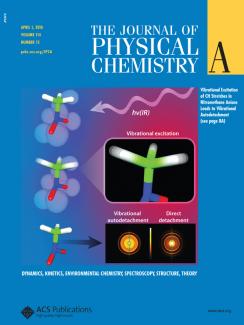Mathias Weber and his team recently did the following experiment: They excited the methyl group (CH3) on one end of nitromethane anion (CH3NO2-) with an infrared (IR) laser. The laser got the methyl group vibrating with enough energy to get the nitro group (NO2) at the other end of the molecule wagging hard enough to spit out its extra electron. The figure here, which appeared on the April 1, 2010, cover of the Journal of Physical Chemistry A, shows an artist’s conception of the process from start to finish. The figure includes two photoelectron spectroscopic images that clearly distinguish between the loss of the extra electron due to nitro-group vibrations versus an ordinary chemical reaction.
Graduate student Chris Adams and former graduate student Holger Schneider (now a postdoc at the Paul Scherrer Institute in Switzerland) worked with Weber on this novel experiment. The experiment is a molecular analog of heat conduction, and molecular-level understanding of this kind of process is important because knowing the way in which energy flows through and gets redistributed in molecules is necessary for understanding and predicting chemical reactions.
Even before doing the experiment, the researchers suspected that the anion would end up emitting its extra electron. The other possible ways for getting rid of the excess energy were much less likely. For instance, the molecule could have fallen apart, but that route would have required more energy than the laser delivered to the molecule in the first place. The molecule could also have stopped vibrating by simply radiating its extra heat into the environment, in a process known as radiative cooling. However, radiative cooling occurs far more slowly than the vibrational detachment of the extra electron.
Consequently, the group opted to look for and study the vibrational detachment of the electron due to laser heating of the methyl end of the molecule. However, for heat to travel through nitromethane anion, the vibrations initiated by the laser in the methyl group had to couple into the nitro group. This end of the molecule is where the extra electron spends most of its time. Adams and his colleagues realized that it wouldn’t take a lot of energy to dislodge this electron because it is quite weakly bound to the molecule. They also knew that if they excited their molecule in a specific way, they would be able to gather information about the processes that occur between the time when the molecule is excited by the laser and when it spits out the extra electron.
The researchers obtained enough information to model the processes they observed. They also began a new experiment in which they used an IR laser to "tickle" the methyl end of a similar, but larger, molecule, nitroethane (C2H5NO2). This molecule also has a nitro group with a weakly bound electron at one end, but vibrations (from heating the other end) have farther to travel to get there. Eventually, these experiments will contribute to understanding heat transfer in molecular chains. This understanding could impact the design of molecular heat sinks for nanotechnology devices and the theory of combustion. - Julie Phillips



 The Physics Frontiers Centers (PFC) program supports university-based centers and institutes where the collective efforts of a larger group of individuals can enable transformational advances in the most promising research areas. The program is designed to foster major breakthroughs at the intellectual frontiers of physics by providing needed resources such as combinations of talents, skills, disciplines, and/or specialized infrastructure, not usually available to individual investigators or small groups, in an environment in which the collective efforts of the larger group can be shown to be seminal to promoting significant progress in the science and the education of students. PFCs also include creative, substantive activities aimed at enhancing education, broadening participation of traditionally underrepresented groups, and outreach to the scientific community and general public.
The Physics Frontiers Centers (PFC) program supports university-based centers and institutes where the collective efforts of a larger group of individuals can enable transformational advances in the most promising research areas. The program is designed to foster major breakthroughs at the intellectual frontiers of physics by providing needed resources such as combinations of talents, skills, disciplines, and/or specialized infrastructure, not usually available to individual investigators or small groups, in an environment in which the collective efforts of the larger group can be shown to be seminal to promoting significant progress in the science and the education of students. PFCs also include creative, substantive activities aimed at enhancing education, broadening participation of traditionally underrepresented groups, and outreach to the scientific community and general public.